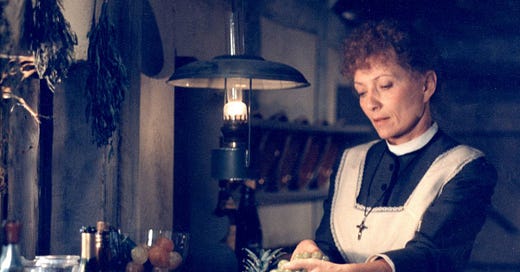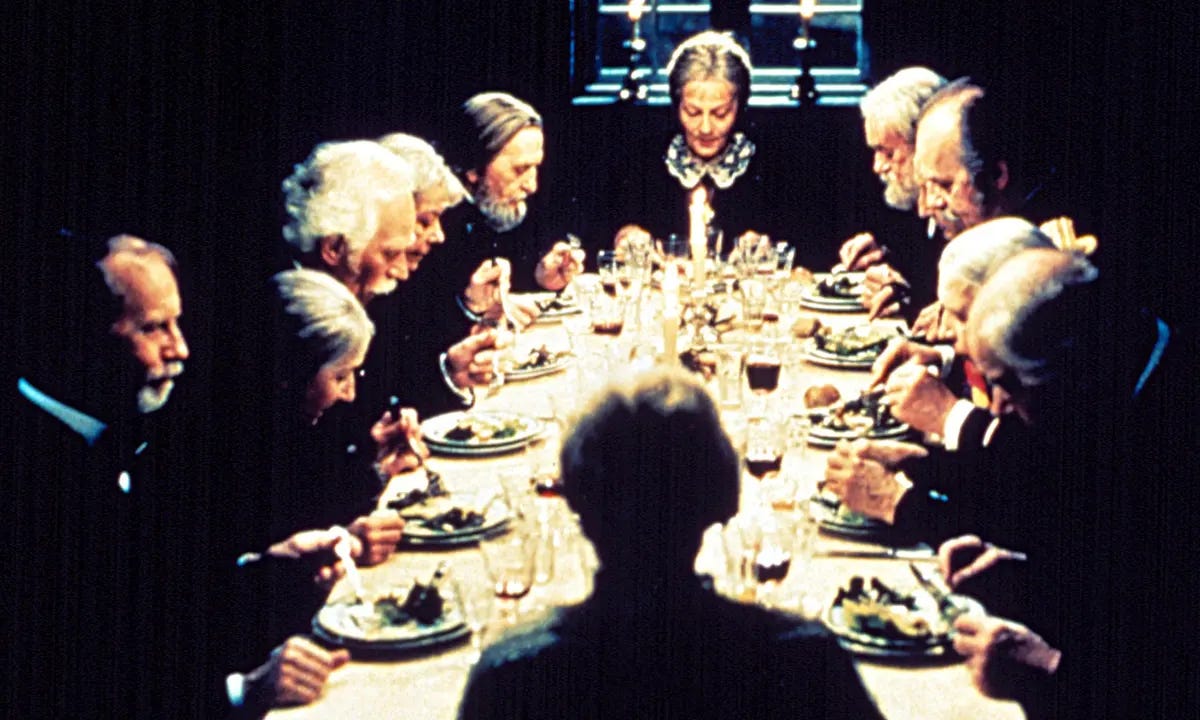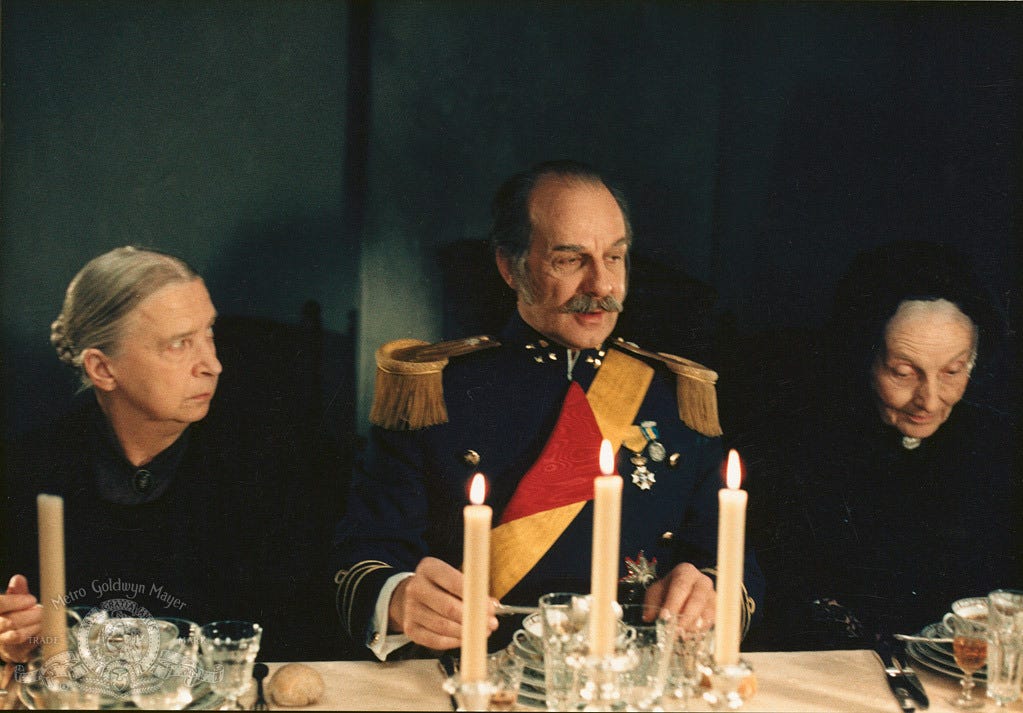Talking about the classic 1987 Oscar winner “Babette’s Feast” with chef Ana Sortun (see the Watchcast that went up earlier today) gives me an occasion to revisit an ode to the movie I wrote several years ago, for a cookbook project that never came to fruition. The piece still sums up my feelings about a film that grows richer and more mysteriously complex the more times you sample it. I offer it to paid subscribers as an after-dinner amusement.
Babette’s Feast (Denmark, 1987, **** stars out of ****)
In a tiny 19th-century seaside village in Denmark, two aging sisters, Martine (Birgitte Federspiel) and Filippa (Bodil Kjer), tend to the elderly flock of their late father’s religious sect. Both women refused chances for love in their youth; both now live a life of charitable, spartan renunciation. A refugee from the revolutions in France is sent to live with them: Babette (Stéphane Audran, above), whose past is ambiguous but who knows her way around a kitchen and so becomes the sisters’ cook. Years pass and Babette comes into sudden wealth; in gratitude, she vows to prepare a true French banquet for the sisters and their parishioners. Also attending is Martine’s former love, now an aging General (Jarl Kulle). The villagers sit down for the feast with near terror at its sumptuous decadence, but the meal becomes a kind of holy communion of body and spirit. Babette, it turns out, is the former chef at the Café Anglais in Paris and an artist of the first rank.
Is Babette’s Feast the best food movie of all time? It’s difficult to argue otherwise; in no other film are the storytelling and the meals equally sublime.
Directed by the late Gabriel Axel and winner of the best foreign language Oscar in 1988, the movie unfolds in a straightforward, even spare manner; a masterpiece of cinematic style this is not. Meanwhile, the attitude of Babette’s Feast toward food is almost unbearably sensual, and in this duality, the film honors both the stripped-down simplicity of the sisters and their brethren -- in which the necessities of life are reduced to minimalist purity -- and the sinfully glorious abundance of the meal prepared by the artist hiding in their midst.
Anyway, the best movies are always about both specific people and the universal, the characters irreducibly themselves yet somehow standing in for all of us. Babette’s Feast honors that equation, with its doddering old acolytes looking to God yet divided by their bickering over grudges and passions decades in the past. How much we hold on to our grievances, as if they define us! And perhaps that’s the point of artistry -- to get us over the hump of our short-sightedness and within range of the eternal.
There’s some sly comedy with the meals Babette has to prepare for years in the sisters’ village: Bread soup of a dreadful muddy color and consistency. It looks, quite literally, like dung. Sustenance, yes, but only the minimum required to prolong human life, and don’t ask what it does for the soul. But then Babette comes into her lottery winnings and things start showing up in the kitchen: A crate of quails, bottles of Veuve Cliquot 1860, and -- most miraculous and, to the sisters, most horrifying of all -- an immense sea turtle, its eyes blinking stupidly in the Nordic chill.
Everything in the film leads up to the feast itself, which is long and luxuriant, the pace of the editing slowing to a dazed amble and the tone itself coming to mirror the way we partake of a very special meal, with attentive savoring and heightened senses. The General is our representative at the feast, a worldly man, successful on the battlefield and in society, yet possessed by a gnawing dissatisfaction over the chances missed in life (or perhaps it’s simply the woman across the table he couldn’t have). The members of the religious sect have never eaten a proper meal before, let alone cailles en sarcophages and turtle soup; Babette’s feast allows them to glimpse the divine but not name it. The general, by contrast, has known fine food -- has, indeed, eaten Babette’s cuisine in Paris, even though (in one of this story’s many small ironies) he has no idea it’s she who’s out there in the kitchen. All he knows is that mercy and bliss have joined hands.
This all may sound silly unless you’ve seen the movie. So see the movie. It’s immensely generous but with an underlying sadness, and it’s aware of how a meal, properly prepared, can absolve all human follies before sending us out into the night. The casting is perfect, with Federspiel and Kjer as the elderly Martine and Philippa gracefully mirroring their younger selves, played by Vibeke Hastrup and Hanne Stensgaard. And what a stroke of genius to cast as Babette Stéphane Audran, who fans of French cinema will recognize as the actress wife of the New Wave director Claude Chabrol and star of some of his slyest, most unnerving work: Les Biches, Les Cousins, Le Boucher. She’s chic and self-possessed and very, very French, and the imperiousness so natural to Babette -- a peacock hiding in a barnyard -- comes right up through her pores.
The filmmaking, as mentioned, never calls attention to itself, which is appropriate. In fact, that refusal to be “showy” is key to an aspect of Babette’s Feast that’s never made explicit in the film but is articulated in its source, the exquisite short story of the same title by Isak Dinesen. Allow me to quote: As the company proceeds through the courses of the feast, they “grew lighter in weight and lighter of heart the more they ate and drank … It was, they realized, when man has not only altogether forgotten but has firmly renounced all ideas of food and drink that he eats and drinks in the right spirit.”
This is awfully close to Zen -- only when you don’t aspire will you attain, only when you don’t savor can you truly taste -- and it’s a sentiment that I sometimes think our burgeoning, often self-satisfied foodie culture would do well to ponder.
Should you read the story? Of course you should, but should you do so before or after watching the movie (and eating the food)? I’d vote for after, to preserve the film’s surprises and to better appreciate the author’s wise, unvarnished prose. What the film expertly shows, the story describes and deepens. “Isak Dinesen,” of course, was the pen name of Karen Blixen, the Danish writer portrayed by Meryl Streep in 1985’s Out of Africa; the original “Babette’s Feast” is in the short story collection Anecdotes of Destiny but can be found online with a simple search. It’s all of 22 pages long and yet, like the movie, it seems to contain everything.
If you enjoyed this edition of Ty Burr’s Watch List, please feel free to share it with friends —
— or leave a comment. Thank you for your support.








